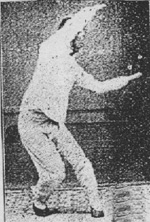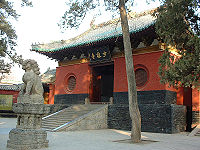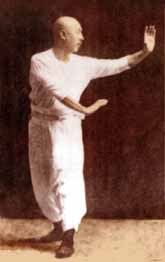Difference between revisions of "Baguazhang" - New World Encyclopedia
MaedaMartha (talk | contribs) (New page: {{Nofootnotes|date=February 2008}} {{Infobox_martial_art | logo = | logocaption = | logosize = | image = Sun bagua.jpg | imagecaption = Sun Lu-t'ang performing cir...) |
MaedaMartha (talk | contribs) |
||
| Line 1: | Line 1: | ||
| − | |||
| − | |||
{{Infobox_martial_art | {{Infobox_martial_art | ||
| logo = | | logo = | ||
Revision as of 16:16, 2 December 2008
| Bāguàzhăng (八卦掌) | |
|---|---|
 Sun Lu-t'ang performing circle-walking | |
| Also known as | Bāguà zhăng; Pa Kua Chang |
| Hardness | Internal (nèijiā) |
| Country of origin | |
| Creator | Dong Haichuan (董海川) |
| Olympic Sport | No |
| Part of the series on Chinese martial arts |

|
| List of Chinese martial arts |
|---|
| Terms |
|
| Historical places |
|
| Historical people |
|
| Related |
|
| view • talk |
Bāguàzhǎng is one of the major "internal" (a.k.a. Nèijiā) Chinese martial arts. Bāguà zhǎng literally means "eight trigram palm," referring to the trigrams of the I Ching (Yijing), one of the canons of Taoism.[1]
History
The creation of Baguazhang, as a formalised martial art, is attributed to Dong Haichuan (董海川) in the early 19th century, who apparently learned from Taoist, and possibly Buddhist, masters in the mountains of rural China.[2] There is evidence to suggest a synthesis of several pre-existing martial arts taught and practised in the region in which he lived, combined with Taoist circle walking. Dong Haichuan taught for many years in Beijing, eventually earning patronage by the Imperial court.[3]
Famous disciples of Dong to become teachers were Yin Fu (尹福), Cheng Tinghua (程廷華), Song Changrong (宋長榮), Liu Fengchun (劉鳳春), Ma Weiqi (馬維棋), Liang Zhenpu(梁振蒲) and Liu Dekuan (刘德宽). Although they were all students of the same teacher, their methods of training and expressions of palm techniques differed.[4] The Cheng and Liu styles are said to specialize in "Pushing" the palms, Yin style is known for "Threading" the palms, Song's followers practice "Plum Flower" (梅花 Mei Hua) palm technique and Ma style palms are known as "Hammers." Some of Dong Haichuan's students, including Cheng Tinghua, participated in the Boxer Rebellion. In general, most Bagua practitioners practice either the Yin (尹), Cheng (程), or Liang (梁) styles of Baguazhang, although Fan (樊), Shi (史), Liu (劉), Fu (傅), and other styles also exist. (The Liu style is a special case, in that it is rarely practiced alone, but as a complement to other styles.)
Modern Styles
- Yin Style: Yin Fu 尹福
- Cheng Style: Cheng Ting Hua 程廷華
- Jiang Style: Jiang Rong Qiao 姜容樵
- Liang Style: Liang Zhen Pu 梁振蒲
- Gao Style
- Fu Style
- Shi Style
- Yin Yang Style (Tian Style)
- Sun Style: Sun Lu-t'ang
- Liu Style: Liu Bao Zhen 刘宝珍
Common Aspects
The practice of circle walking, or 'Turning the Circle', as it is sometimes called, is baguazhang's characteristic method of stance and movement training. Practitioners walk around the edge of a circle in various low stances, facing the center, and periodically change direction as they execute forms.[5] Students first learn flexibility and proper body alignment through such exercises, then move on to more complex forms and internal power mechanics. The internal aspects of baguazhang are very similar to those of xingyi and tai chi.
Many distinctive styles of weapons are contained within baguazhang, some use concealment like the "scholar's pen" or a pair of knives (the most elaborate which are unique to the style are the crescent-shaped deer horn knives). Baguazhang is also known for practicing with extremely large weapons, such as the Bāguàdāo (八卦刀), or 'Bagua Broadsword'. Other more conventional weapons are also used like the staff, straight (double-edged) sword, and spear. Baguazhang practitioners are also known for being able to use anything as a weapon using the principles of their art.
Baguazhang contains an extremely wide variety of techniques, including various strikes (with palm, fist, elbow, fingers etc), low kicks, joint locking techniques, throws, and distinctively evasive circular footwork.
See also
- Nèijiā
- Liuhebafa
- Neigong
- Neijin
- Pushing hands
- Jing (TCM)
- Pa Kua
| ||||||||||||||||||||
• The Martial Arts Portal •
| Brazil: Brazilian Jiu-Jitsu • Capoeira China: Egypt: France: Greece: Iceland: India: |
Iran: Varzesh-e Pahlavani Israel: Japan: Korea: Philippines: Portugal: Ryūkyū Kingdom: |
SERBIA: Real Aikido • Ljubomir Vracarevic Thailand: Turkey: Union of Soviet Socialist Republics: United Kingdom United States of America: Vietnam: |
Unknown or no single origin:
Boxing • Catch wrestling • Fencing • Silat • Stick fighting • Wrestling
ReferencesISBN links support NWE through referral fees
- Robert W. Smith, Chinese Boxing, ISBN 1-55643-085-X
- Bok Nam, Park & Dan Miller, The Fundamentals of Pa Kua Chang: The Methods of Lu Shui-T'ien As Taught by Park Bok Nam., ISBN 0-86568-173-2
- Shou-Yu, Liang, Baguazhang : Emei Baguazhang Theory and Applications, ISBN 0-940871-30-0
- O'Brien, Jess, Nei Jia Quan: Internal Martial Arts Teachers of Tai Ji Quan, Xing Yi Quan, and Ba Gua Zhang ISBN 1-55643-506-1
- Frantzis, Bruce Kumar, The Power of Internal Martial Arts: Combat Secrets of Ba Gua, Tai Chi, and Hsing-I ISBN 1-55643-253-4
Notes
- ↑ Lie, Zhang. “Classical Baguazhang Volume V: Yin Style Baguazhang.” Trans. Joseph Crandall. Pinole, California: Smiling Tiger Martial Arts 1995.
- ↑ Yintao, Fei and Yuliang, Fei. “Classical Baguazhang Volume IV: Wudang Baguazhang.” Trans. Joseph Crandall. Pinole, California: Smiling Tiger Martial Arts 1994.
- ↑ Jingru, Liu and Youqing, Ma. “Classical Baguazhang Volume II: Cheng Shi Baguazhang (Cheng Family Baguazhang).” Trans. Joseph Crandall. Pinole, California: Smiling Tiger Martial Arts 2001.
- ↑ Lie, Zhang. “Classical Baguazhang Volume V: Yin Style Baguazhang.” Trans. Joseph Crandall. Pinole, California: Smiling Tiger Martial Arts 1995.
- ↑ Lie, Zhang. “Classical Baguazhang Volume V: Yin Style Baguazhang.” Trans. Joseph Crandall. Pinole, California: Smiling Tiger Martial Arts 1995.
External links
- The Yin and Yang of Ba Gua Zhang: The Legends of Thin Yin and Spectacles Cheng by Frank Allen & Clarence Lu
- Emptyflower Discussion Forum for Baguazhang and other internal Neijia Arts
- Descriptions of Baguazhang forms
Credits
New World Encyclopedia writers and editors rewrote and completed the Wikipedia article in accordance with New World Encyclopedia standards. This article abides by terms of the Creative Commons CC-by-sa 3.0 License (CC-by-sa), which may be used and disseminated with proper attribution. Credit is due under the terms of this license that can reference both the New World Encyclopedia contributors and the selfless volunteer contributors of the Wikimedia Foundation. To cite this article click here for a list of acceptable citing formats.The history of earlier contributions by wikipedians is accessible to researchers here:
The history of this article since it was imported to New World Encyclopedia:
Note: Some restrictions may apply to use of individual images which are separately licensed.
